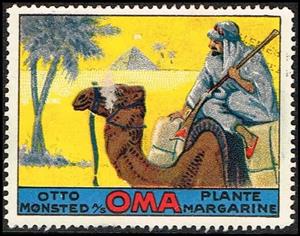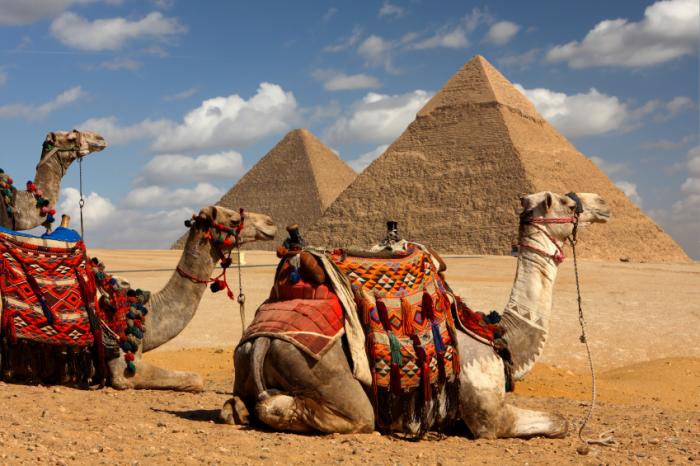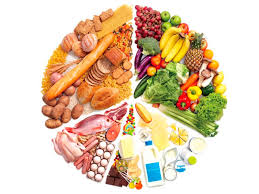Stamp: Otto Moensted A S Oma Plantemargarine Camel (Cinderellas 1920)
Otto Moensted A S Oma Plantemargarine Camel (Cinderellas 1920)
01 January (Cinderellas ) within release Denmark goes into circulation Stamp Otto Moensted A S Oma Plantemargarine Camel face value None No Face Value
| Stamp Otto Moensted A S Oma Plantemargarine Camel in catalogues | |
|---|---|
| Colnect codes: | Col: DK 1920-47/2 |
Stamp is square format.
MargarineAlso in the issue Denmark:
- Stamp - Export flode face value None;
- Stamp - Kaempehoj face value None;
- Stamp - Kaempehoj face value None;
- Stamp - Al Saasaed Og Froe Med Sanagran Afsvamp face value None;
- Stamp - Almindeligt Dansk Vare Og Industrilotteri face value None;
- Stamp - Arbeidernes Laeseselskabs Byggefond 50 Oere face value 50;
- Stamp - Avis Folkets Avis Laeses Overalt Faas Overalt face value None;
- Stamp - Avis Laes Koebenhavn Fru Hansen And Fru Petersen face value None;
- Stamp - Avis Politiken face value None;
- Stamp - B S S F 1881 10 face value 10;
- Stamp - Blad Hjemmet Er Damernes Bedste Raadgiver Thin face value None;
- Stamp - Boernenes Kontor Boernehjaelps Dagen Maj 1920 face value None;
- Stamp - C R Evers And Co Maltextrakt Bolcher Med Mentol face value None;
- Stamp - C R Evers And Co Maltsaft Vacuums face value None;
- Stamp - Charles Christensen Material Kemisk Teknisk Fabrik And face value None;
- Stamp - Charles Christensen Tapeter face value None;
- Stamp - Chic Floede Karamel Dansk Engelsk Caramelfabrik face value None;
- Stamp - Chic Floede Karamel Dansk Engelsk Caramelfabrik face value None;
- Stamp - Chic Floede Karamel Smager Bedst face value None;
- Stamp - Christian D I 1448 1481 A S Koebenhavns Lakridsfabrik face value None;
- Stamp - Christian D Iv 1588 1648 A S Koebenhavns Lakridsfabrik face value None;
- Stamp - Christian D V 1670 1699 A S Koebenhavns Lakridsfabrik face value None;
- Stamp - Dal face value None;
- Stamp - Danebrog Danevirke Danmark face value None;
- Stamp - Danmark Frit For Rusdrikke face value None;
- Stamp - Dansk Engelsk Caramelfabrik Chic Floede Carameller Smager face value None;
- Stamp - Dansk Engelsk Caramelfabrik Spis Chic Floedekarameller face value None;
- Stamp - De Unges Idraet 1905 1920 Jubilaeums Maerke face value None;
- Stamp - Den Sikre Havn Hafnia Livsforsikring face value None;
- Stamp - En Ting Mangler Ved Den Have face value None;
- Stamp - Faedrejord Og Faedrearv Vaernes Maa Til Egen Tarv face value None;
- Stamp - Forlang Prisliste Koebenhavns Kolonialforsyning face value None;
- Stamp - Fredericia Danebrog face value None;
- Stamp - Frimurerlogen I Odense 3 Juni 1920 Clear Set Off Reverse face value None;
- Stamp - Garanti Skilt Dansk Smoerhandlerforening face value None;
- Stamp - Garanti Skilt Dansk Smoerhandlerforening face value None;
- Stamp - H A Andv F 8 Kreds Gave Fra Kvinder I Nyboder Hoeires Arbejd face value None;
- Stamp - H A Andv F 8 Kreds Gave Fra Kvinder I Nyboder Hoeires Arbejd face value None;
- Stamp - H A Andv F 8 Kreds Gave Fra Kvinder I Nyboder Hoeires Arbejd face value None;
- Stamp - H A Andv F 8 Kreds Gave Fra Kvinder I Nyboder Hoeires Arbejd face value None;
- Stamp - Handels Reisende Maerke face value None;
- Stamp - Hans 1481 1513 A S Koebenhavns Lakridsfabrik face value None;
- Stamp - Hans Larsens Minde For De Gamles Sag face value None;
- Stamp - Hjaelp For Alkohol Patienter Thorsgade 40 face value None;
- Stamp - Hjaelp For Alkohol Patienter Thorsgade 40 face value None;
- Stamp - Hoeires Arbejder Og Vaelgerforening 2den Kk 1886 face value None;
- Stamp - Hoeires Arbejder Og Vaelgerforening 2den Kk 1886 face value None;
- Stamp - Hoeires Arbejder Og Vaelgerforening 2den Kk 1886 face value None;
- Stamp - Hoeires Arbejder Og Vaelgerforening 2den Kk 1886 face value None;
- Stamp - Hoeires Arbejder Og Vaelgerforening 2den Kk 1886 face value None;
- Stamp - Hoeires Arbejder Og Vaelgerforening 2den Kk 1886 face value None;
- Stamp - Hoeires Arbejder Og Vaelgerforening 2den Kk 1886 face value None;
- Stamp - Hoejres Hus Byggefond face value None;
- Stamp - I Skal Ikke Blive Glemt Stoet Graenseforeningen face value None;
- Stamp - Jensen And Moeller Konfekture Fabrik face value None;
- Stamp - Jettadams Galla Glans face value None;
- Stamp - Journalist Foreningen I Kjoebenhavn 1880 Sic Nos Non Nobis face value None;
- Stamp - Koebenhavn Koge Udstillingen face value None;
- Stamp - Koebenhavns Kommunes Feriefond Kkf 25 Oere H C Andersen face value 25;
- Stamp - Koebenhavns Kommunes Feriefond Kkf 25 Oere H C Andersen (1) face value 25;
- Stamp - Kolding face value None;
- Stamp - Lokomotivpersonalets Hjaelpefond 1 Kr face value 1;
- Stamp - Modersmaal Er Vort Hjertesprog Kun Loes Er Al Fremmed Tale face value None;
- Stamp - Olympiaden 1920 Antwerpen Belgium face value None;
- Stamp - Otto Moensted A S Oma Plantemargarine Camel face value None;
- Stamp - Otto Moensted A S Oma Plantemargarine Camel face value None;
- Stamp - Otto Moensted A S Oma Plantemargarine Camel face value None;
- Stamp - Otto Moensted A S Oma Plantemargarine Canoe face value None;
- Stamp - Otto Moensted A S Oma Plantemargarine Canoe face value None;
- Stamp - Otto Moensted A S Oma Plantemargarine Canoe face value None;
- Stamp - Otto Moensted Oma Plantemargarine No 11 Mejeriet face value None;
- Stamp - Otto Moensted Oma Plantemargarine No 3 Kokosnoedderne face value None;
- Stamp - P A E Muller Koebenhavns Honninghus Enhver Som Daglig face value None;
- Stamp - P Lykkeberg Kjoebenhavn Gold face value None;
- Stamp - Pintsen 1920 Dansk Skraedderforbunds Hjaelpefond face value 1;
- Stamp - Pratt Benzin face value None;
- Stamp - Skatterne Ned face value None;
- Stamp - Slagelse Fjerkrae Udstillingen 24 27 Juni face value None;
- Stamp - Soefyrboedernes Byggefond Krone 1 Krone face value 1;
- Stamp - Til Gamle Medlemmer Understoettelses Fondet 25 Oere De face value 25;
- Stamp - Til Kirken I Soeborg 10 Oere face value 10;
- Stamp - Vaer Beredt Til Fordel For Spejderlejrene face value None;
- Stamp - Vaer Beredt Til Fordel For Spejderlejrene face value None;
- Stamp - Vaernepligtens Nederlag Varsler Fredens Sejrsdag face value None;
- Stamp - Velgorenhedi Maerke Odder Christmas Seal face value 2;
- Stamp - Velgorenhedi Maerke Odder Christmas Seal face value 5;
|
Data entry completed
50%
|
|
|---|---|
| Stamp Otto Moensted A S Oma Plantemargarine Camel in digits | |
| Country: | Cinderellas |
| Date: | 1920-01-01 |
| Emission: | Cinderella |
| Format: | Stamp |
| Face Value: | None No Face Value |
Stamp Otto Moensted A S Oma Plantemargarine Camel it reflects the thematic directions:
A camel (from Latin: camelus and Greek: κάμηλος (kamēlos) from Ancient Semitic: gāmāl) is an even-toed ungulate in the genus Camelus that bears distinctive fatty deposits known as "humps" on its back. Camels have long been domesticated and, as livestock, they provide food (camel milk and meat) and textiles (fiber and felt from camel hair). Camels are working animals especially suited to their desert habitat and are a vital means of transport for passengers and cargo. There are three surviving species of camel. The one-humped dromedary makes up 94% of the world's camel population, and the two-humped Bactrian camel makes up 6%. The wild Bactrian camel is a separate species and is now critically endangered.
Food is any substance consumed by an organism for nutritional support. Food is usually of plant, animal, or fungal origin and contains essential nutrients such as carbohydrates, fats, proteins, vitamins, or minerals. The substance is ingested by an organism and assimilated by the organism's cells to provide energy, maintain life, or stimulate growth. Different species of animals have different feeding behaviours that satisfy the needs of their metabolisms and have evolved to fill a specific ecological niche within specific geographical contexts.


